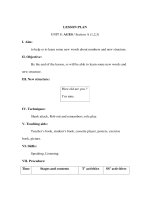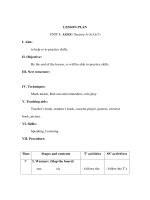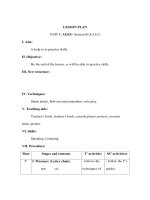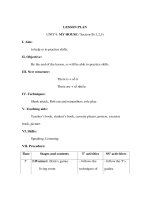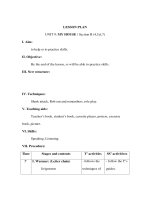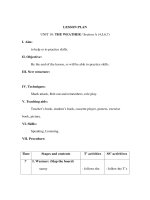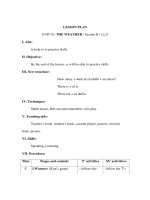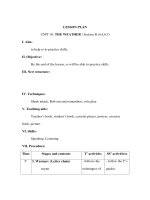GIÁO ÁN TIẾNG ANH LỚP 9
Bạn đang xem bản rút gọn của tài liệu. Xem và tải ngay bản đầy đủ của tài liệu tại đây (557.81 KB, 117 trang )
1 Giáo án Tiếng Anh 9
WEEK 1
PERIOD 1: INTRODUCTION
PERIOD 2: CONSOLIDATION
PERIOD 3: QUALITY CHECKING UP
UNIT 1: A VISIT FROM A PEN PAL
I. General objectives:
1. Competencies:
- Make & respond to introduction
- How to compare with the likeness and the difference.
- Scan for specific information.
2. Language focus:
- Past simple tense
- Present unreal wish
II. Techniques: Brainstorming; Questions – answers
III. Etching aids: Cassette; Cassette recorder; illustrating pictures; OPH;
Pictures; Visual aids; Laptop; Flash cards, colored chalk.
UNIT 1: A VISIT FROM A PEN PAL
Week 2. Period 4 + 5. Lesson 1: Getting started – Listen and read
I. Objectives:
- Introduce, leading to the topic of a unit
- Talking about places to visit
II. Grammar: Wish sentence & Past habit Used to + Verb
III. Vocabulary: Words relating to famous place to visit & activities done during the visit
Content
Teacher’s activities Student’s activities
I. Class order
II. Check up
III. New lesson
Warm – Up
(15’)
* Getting started.
- Showing 6 pictures of places of interest of Vietnam
- Eliciting the places of interest of Ho Chi Minh City
- Asking them some questions
1. Do you have any pen pals?
2. Do you like to have pen pals?
3. Where will you take him if he visits Vietnam for the
1
st
time?
4. Can you tell me the names of the places in 6
pictures?
- Teaching new words: Hung Temple; Temple of
- Looking at the 6 pictures and
guessing what places they are.
- Answering the questions.
-Listening to the teacher’s
explanations then write the
vocabulary down.
2 Giáo án Tiếng Anh 9
Lead-in
(30’)
Literature; Dong Xuan Market; the City hall; Ho
Chi Minh history museum; Ben Thanh market.
* Listen and read
- Introducing the situation of the passage: Rizal Mary
is, Lan’s pen pal visited her for the fist time and Lan
took her to some places of interest in Hanoi.
- Playing cassette once the 1
st
paragraph.
- Asking them questions: What do you know about
Mary am?
- Having them a silent reading then identifying the
places of interest.
- Playing cassette again.
- Explaining the new difficult words: Mosque;
peaceful; keep in touch; atmosphere
- Reminding them of new and old structures.
* Old Structure: Past habit
Used to + V
* Ex: Lan used to walk past the mosque on her way to
primary school.
* New structure:
Wish sentence: Present unreal wish
* Ex: I wish I had more time.
- Asking them to have silent reading for information to
answer the questions.
- Calling some students to say their choices.
- Briefly explaining the use of Wish
Ex: I wish I had more time.
I wish + clause (Past simple)
Practice:
1. I don’t have enough money.
I wish …………………………
2. I can’t sing that song
I wish …………………………
3. It’s raining.
I wish …………………………
4. I am too fat.
I wish …………………………
5. The weather is bad to day.
I wish …………………………
- Listening to the teacher
- Listening to cassette.
- Answering the question.
- Having a silent reading.
- Listening to the cassette.
- Writing down the new words.
- Finding out structures.
- Identifying new structures.
- Having silent reading and get
more information.
- Saying the choices.
- Doing the practice.
1. I wish I had enough money.
2. I wish I could sing that song.
3. I wish it wasn’t raining.
4. I wish I weren’t too fat.
5. I wish the weather were fine
today.
IV. Consolidation
1. Where did Lan take Mary am to visit?
2. What place did they visit on Friday?
3. What new structure is there in the passage?
V. Homework
- Do exercise 1 workbook (p.5-6).
- Explain the way how to do these
exercises.
Adjustment:
3 Giáo án Tiếng Anh 9
UNIT 1: A VISIT FROM A PEN PAL
Week 2. Period 6. Lesson 2: Speak
I. Objectives:
- Developing speaking skills.
- Introducing oneself
II. Language contents:
1. Grammar: Yes – No questions.
2. Vocabulary: Some words relating to capitals and big cities in the word, especially in Asia.
III. Techniques:
Asking and answering – Pair work – Role play – Matching.
IV. Teaching aids:
Pictures
V. Time: 45 minutes
VI. Procedures:
Content
Teacher’s activities Student’s activities
I. Class order
II. Check up
III. New lesson
Warm – up
(3’)
- Making questions:
1. Where does Mary is come from?
2. Does she like Vietnamese people?
3. Does she like Ha Noi?
- Answering the questions:
1. Malaysia – Kuala Lumpur
2. Friendly
3. Interesting
Presentation
(7’)
-Introducing situation.
-Asking Sts to work in pairs.
- Matching and putting the dialogues in the
correct order.
Finishing part (a)
Practice (13’)
- Correcting part (a)
- Sticking the answer key on the board.
- Asking Sts to read the information in three boxes
at the end of the page 8.
- Replacing
- Making similar dialogues.
- Practicing new dialogues (Pair work)
IV. Free
practice (5’)
- Asking Sts to match countries and their capitals
(ASIA).
- Asking Sts to play roles.
- Matching
- Playing roles with their old names and
their own words.
V. Homework - Asking Sts to prepare 4
Adjustment:
UNIT 1: A VISIT FROM A PEN PAL
Week 3. Period 7. Lesson 2: Listen
I. Objectives:
- Developing listening skills.
4 Giáo án Tiếng Anh 9
II. Language contents:
3. Grammar: Yes – No questions.
4. Vocabulary:
III. Techniques:
Asking and answering – Pair work – Role play – Matching.
IV. Teaching aids:
Pictures, cassette player and tape.
V. Time: 45 minutes
VI. Procedures:
Content
Teacher’s activities Student’s activities
I. Class order
II. Check up
III. New lesson
Pre-listening
(3’)
- Introducing the lesson - Looking at the picture and taking about
them.
While-listening
(10’)
- Taking about the situation of the
lesson.
- Playing the tape.
- Listening and finding out where Tim
and Carol are and that they are doing.
- Listening and choosing the correct
answers.
- Comparing their answers with the
partner’s.
IV. Post-
listening (4’)
- Checking the answers with the whole class. - Saying the answers.
V. Homework - Asking Sts to prepre 5.
Adjustment:
UNIT 1: A VISIT TO A PEN PAL
Week 3. Period 8. Lesson 3: Read
I. Objectives:
1. Developing speaking and listening skills.
2. Help students to know more about Malaysia.
II. Language contents:
Vocabulary: divided, separated, comprise tropical climate, official, language of instruction.
III. Techniques:
5 Giáo án Tiếng Anh 9
Communicative approach.
IV. Procedures:
Steps Teacher’s activities Student’s activities
I. Class order
II. Check up
III. New lesson
Warm-up
- T shows the map of Vietnam and asks students:
1. Which country is on the map?
2. Which city is the capital of Vietnam?
3. How many regions are there in Vietnam?
- Answering the questions.
Pre-reading
- T introduce a the passage by showing the map
and the picture about Malaysia.
- T asks “What do you know about Malaysia.
- T asks sts to read the passage silently and
underline the new words.
- T explains new word (translation method)
- Sts answer (in Vietnamese)
- Reading the passage in silently an
underline the new word
- Listening to the explanation.
While-reading
- T reads the passage and students listen and find
the right information about Malaysia to fill in the
table. (pair word)
- Sts read their answer sentences.
Post-reading
- T hangs a cardboard and gets sts to do T/F
exercises in pairs.
- T asks some pairs to write their answers on the
board.
- T gives answer keys and corrects them.
- Doing the exercise in pairs.
- Answering the questions.
- Correcting the mistakes.
Feed-back
- T asks. For the false statements T asks sts to
give the correct ones.
- Giving the correct statements.
IV.
Consolidation
- T gives some questions about Malaysia:
1. Is Malaysia one of the countries of the
ASEAN?
2. How many regions are there?
3. Is Kuala Lumpur the largest city in the
country?
4. Which language is taught on secondary school?
5. What’s the weather like in Malaysia?
- Answering the questions.
V. Homework
- Learning the new words by heart.
- Rereading the passage.
Adjustment:
UNIT 1: A VISIT TO A PEN PAL
Week 3. Period 9. Lesson 4: Write
I. Aims:
Sts can practice the skill of writing a letter (a normal letter and a friendly letter)
II. Teaching aids:
6 Giáo án Tiếng Anh 9
Pictures of some places of interest ( Hoan Kiem Lake, West Lake, London Bridge, etc), Overhead,
projector.
III. Teaching steps:
Content
Teacher’s activities Student’s activities
I. Class order
II. Check up
III. New lesson
Warm-up
- T introduces the topic of the lesson by
telling the sts his/her trip. Then T ask sts
some questions:
a. When did you go last summer?
b. Do you have any relatives?
c. Have you ever visited them?
d. Could you tell us about your trip?
- Answering the questions.
Presentation
- T reads a sample letter.
- T guides sts how to write a letter (address,
heading, body, closing, signature…)
- Listening to the teacher.
Practice
- T has some sts read their letters in front of
the class.
- T corrects the mistakes.
- Sts read the outline, pay attention
to he content of each part.
- Sts base on the outline and
teacher’s instructions and write a
letter.
- Sts discuss in groups and write
letters by themselves.
IV. Consolidation
- How to write a friendly letter
V. Homework
- Sts write letters to invite their
friends to their places where they
are living, tell them what they’ll do,
what food they’ll eat …
Adjustment:
UNIT 1: A VISIT FROM A PEN PAL
Week 4. Period 10 + 11. Lesson 5: Language focus
I. Objectives:
Students can retell their preparations before a special occasion and express their wish.
II. Language content:
Grammar: Revision:
- Past simple.
- Wish sentence.
III. Technique:
Question – Answer.
IV. Teaching aid:
Pictures, colored chalk.
V. Procedure:
7 Giáo án Tiếng Anh 9
Content
Teacher’s activities Student’s activities
I. Class order
II. Check up
III. New lesson
Past simple
(page 11)
Exercise 1 page 11
Exercise 2 page 12
Exercise 3 page 12
The past simple with wish:
S1 V1 S2 V2
I wish you had a longer vacation.
S1 V1 S2 V2
I wish I had more time.
S1 + WISH S2 + verb
_be (were)
_/v(past)
IV. Consolidation
V. Homework
- Creating the situation by asking
some questions:
1. Where was Mary am last
week?
2. What did she do in her first day
in HN ?
- Asking the students to pick out the
tenses in 2 answers.
- Having some students give the
formation of past simple tense.
- Asking the students to do pair word
(exercise 1)
- Having some pairs present in front
of the class.
- Having the students do group work
and the quickest group present their
key on the board.
- Creating the situation by asking
questions:
“What did Lan say to Mary am at the
end of the week?”
- Asking the students to analyze the
sentence.
- Having the students withdraw
conclusion.
- Asking the sts to do exercise 3 page
12 (group work)
- Having some of the sts write their
sentences on the blackboard.
- Giving comments or corrects the
mistakes if necessary.
- Asking the sts to give the formation
of wish sentence.
- Asking the sts to write five wish
sentences.
- Answering the T/s questions.
1. She was in HN
2. Lan took her to HOAN KIEM
lake.
1. What did Lan do on the
Weekend?
- She went to the concert.
2. When did she go there?
- She went there on Saturday at
8pm.
Exercise 2:
- Lan made a cake
- Tan hang colorful lamps.
- They bought flowers.
- Huy paint a picture of HN
- They went shopping.
Exercise 3:
- “ I wish you had a longer
vacation”
- Wish sentence => a complex
sentence.
- Verb is used in the past
subjunctive.
Exercise 3:
a. I wish I were taller
b. I wish it were not so hot
c. I wish I had a computer
d. I wish I didn’t do it’s.
Adjustment:
8 Giáo án Tiếng Anh 9
UNIT 2: CLOTHING
I. General objectives:
1. Competencies:
- Ask and answer about habits and personal taste of dreading.
- How to present personal ideas in written form about the simple.
- Problems referred to the topic using the readily-given prompts.
2. Language focus:
- The present perfect tense.
- Passive voice review.
II. Techniques:
Brainstorming; Questions – answers.
III. Teaching aids:
Cassette; Cassette recorder; illustrating picture; OPH; Picture; Visual aids; Laptop; Flash cards; colored
chalk.
UNIT 2: CLOTHING
Week 4. Period 12 + 13. Lesson 1: Getting started – Listen and read
I. Objectives:
- Introduce, leading to the topic of a unit: The traditional Ao Dai of Vietnam
- Remind them of some countries the word with their customs.
II. Grammar: The present perfect tense.
III. Vocabulary: word relating to ways of dressings.
Steps Teacher’s activities Student’s activities
I. Class order
II. Check up
III. New
lesson
Warm-up
• Getting started
- Showing 6 pictures of people with their
costumes.
- Eliciting the name of some countries.
- Asking them some questions.
1. Where does she come from?
2. Why do you know she come from Japan?
- Teaching new words; a kimono; a sari; a veil.
- Calling some group reprentatives to answer in
front of the class.
- Looking at the 6 pictures and guessing
what countries they are.
- Answering the questions.
- Discussing in groups.
* Sample Key:
1. She comes from Japan
2. She comes from Vietnam
3. He comes from Scotland.
4. She comes from India.
5. He comes from the USA.
6. She comes from (Saudi) Arabia.
- Listening to the teacher’s explanations
then wire the vocabulary down.
9 Giáo án Tiếng Anh 9
- Correcting their mistakes if possible.
Lead-in
• Listen and read
- Introducing the situation of the passage.
“ Ao dai is the traditionally unique dress of
Vietnam. They are being used by both man and
woman in specific occasions. It has now being
changed in different designs for fashion.”
- Playing cassette once the 1
st
paragraph.
- Asking them questions:
1.What is Ao Dai?
1. What are women do nowadays?
2. What do women also prefer?
3. What do the designer do to the Ao
Dai?
- Having them a silent reading then identifing the
main idea of the passage.
- Playing cassette again.
- Explaining the new difficult words; “poet’
mention; consist; of; to slit; inspiration;
unique; convenient; along silk tunic; ethnic
minoritres”
- Reminding them of new and old structures:
1. Old Structure: Past habit
2. Used to + V
Eg: Lan used to walk past the mosque on her
way to primary school.
3. New structure:
Wish sentence: Present unreal wish
Eg: I wish I had more time
- Asking them to have silent reading for
information to answer the questions.
- Calling some students to say their choices.
- Briefly explaining the used of wish.
=> I wish I had more time.
I wish + clause (Past simple)
Practice:
1. I don’t have enough money.
I wish …………………………
2. I can’t sing that song.
I wish …………………………
3. It’s raining.
I wish …………………………
4. I am too fat.
I wish …………………………
5. The weather is bad today
I wish …………………………
- Listening to the teacher.
- Listening to cassette.
- Answering the question.
- Having a silent reading
- Listening to the cassette.
- Writing down the new words
- Finding out structures.
- Identifying new structure.
- Having silent reading and get more
information.
- Saying the choices.
- Doing the practice
1. I wish I had enough money
2. I wish I could sing that song
3. I wish it’s wasn’t raining
4. I wish I weren’t too fat
5. I wish the weather were fine today.
10 Giáo án Tiếng Anh 9
IV.
Consolidation
- The present perfect tense.
- Traditions in some countries.
V. Home work
- Completing the sentences and answer the
questions. (Page 14)
Adjustment:
UNIT 2: CLOTHING
Week 5. Period 14. Lesson 2: Speak
I. Objectives:
1. Competencies:
- Develop speaking skill.
- Ask & answer about the hobby and the habits of dressing.
2. Language focus:
a. Grammar:
- The Simple Present Tense
- The Simple Past Tense
b. Vocabulary:
- A colorful T-shirt; a plaid skirt; a plain suit; a short-sleeved; blouse; a sleeveless sweater; a striped
shirt; baggy pants; faded jeans; blue shorts.
II. Techniques:
Brainstorming; questions – answers; guessing
III. Teaching aids:
Cassette; cassette recorder; illustrating pictures; ohp; pictures; visual aids; laptop; flashcards; colored
chalk.
IV. Teaching steps:
Content Teacher’s activities Student’s activities
I. Class order
II. Check up
III. New lesson
Warm – Up
Presentation
Pre-speaking
- Asking students to answer some questions
about clothes:
1. What type of clothing do you wear at
school?
2. What’s this? It’s a skirt / a blouse …
- Introducing some new words referred to kinds
of clothiers.
- Asking some questions:
1. What do you usually wear on the weekends?
2. Why are you wearing these clothes?
- Listening to the teacher’s questions and
answer.
- Looking at the new words and repeats
after the teacher.
- Learning the new vocabularies.
- Answering the questions in pairs.
11 Giáo án Tiếng Anh 9
3. What is your favorite type of clothing? Why?
4. School uniform: is it comfortable?
5. What color is it?
- Asking them to match the pictures the given
words.
- Matching thru picture with the words.
* Key:
a. A sleeveless sweater (5)
b. A striped shirt (6)
c. A plain suit (3)
d. Faded jeans (8)
e. A short-sleeved
f. A blouse
g. Baggy pants (7)
h. A plaid skirt (2)
i. Blue shorts (9)
Practice
While-speaking
Controlled
practice
- Letting the students to ask each other in groups
about their habit of dressings.
- Correcting their mistakes in spelling.
- Calling some groups to present their interview
before class.
- SS ask the members of the other group
about the clothes they wear on the
weekend.
- Presetting their interview before class.
Reproduction
Post-speaking
- Asking the students to answer the questions :
1. What type of clothing do you wear on tet
holiday?
2. What would you wear to a party?
- Asking them to summarize what kind of clothes
they usually wear at school, at the party or on
Tet holidays.
- Answering the questions.
- Summarizing the habit of dressing on
special occasion.
IV.
Consolidation
- Making up another conversation between you
and your friend referred to the habits of dressing
on special occasion.
- Reminding them the questions “What is your
favorite type of clothing?”
V. Homework
- Doing exercise 3, 4 workbook (page
14.15)
- Explaining the way how to do the
exercises.
Adjustment:
UNIT 2: CLOTHING
Week 5. Period 15 Lesson 3: Listen
I. Objectives:
1. Competencies:
- Developing reading skills.
- Listening for realistic information about some event.
12 Giáo án Tiếng Anh 9
2. Language focus:
a. Grammar:
Passive construction of past simple.
b. Vocabulary:
Attention; special; announce; entrance; wear; long-sleeved blouse; information desk.
II. Techniques:
Brainstorming; Questions – answers; guessing.
III. Teaching aids:
Cassette; Cassette recorder; illustrating pictures; OHP; Pictures; Laptop; Flash cards; colored chalk.
IV. Teaching steps:
Content Teacher’s activities Student’s activities
I. Class order
II. Check up
III. New lesson
Warm – Up
Presentation
Pre-speaking
- Introducing the pictures divided into three
groups of different clothes.
- Asking them some questions to remind them
the vocabulary questions:
1. What do you call these clothes in English?
2. Have you ever worn them?
- Introducing the situation of the coming
announcement.
“Mary, a three-year-old girl is reported missing
at the Car Fair”
- Asking them to listen and catch up with the
information “What is Mary wearing?”
- Looking at the pictures and discuss their
names on groups.
- Answering the questions.
- VOC: trousers; shorts; skirt; blouse;
sandals; shoes; boots
- Yes, we have
- Listening to the situation.
- Listening, and then catching up with the
necessary information.
While-listening
- Playing cassette twice without pause.
- Letting them guess in pairs “What is Mary
wearing?”, then compare with the pictures.
- Marking the correct pictures.
- Play cassette again.
- Letting them make a good choice.
- Listening to the cassette.
- Doing pair work.
- Marking the pictures.
- Listening again.
- Making a good choice.
* Tape script:
Attention please. Here is a special
announcement. A little girl is reported
missing. She was last seen 20 minutes ago
near the main entrance to the Car Fair.
Her name’s Mary and she are 3 year old.
She has short dark hair. She is wearing
shorts-blue shorts and a long-sleeved
white blouse. She’s wearing a pair of
shoes – brown shoes. She may be carrying
a large doll.
If you see Mary, please bring her to the
information desk. Her father’s waiting for
her there. Thank you.
Post-listening
- Asking the students to compare their choices
with partner.
- Comparing their choice with partner.
- Saying the choices before class.
13 Giáo án Tiếng Anh 9
- Calling some students to give the answer.
- Giving them the key
- Listening to the key and correct.
* KEY:
1. She’s wearing blue shorts.
2. She’s wearing a long-sleeved white
blouse.
3. She’s wearing brown shoes.
IV.
Consolidation
- Repeating the words referred to clothes by
looking at the pictures.
- Reminding them the passive structure.
V. Homework
- Doing exercise 5, 6 workbook (page
16,17)
- Explaining the way how to do the
exercises.
Adjustment:
UNIT 2: CLOTHING
Week 6. Period 16 Lesson 4: Read
I. Objectives:
1. Competencies:
- Developing reading skill.
- Searching for information about the history of the development of jeans.
2. Language focus:
a. Vocabulary: words related to the history of jeans: sailor; embroidered jeans; label; generation
worldwide.
b. Grammar: passive voice (past simple).
II. Techniques:
Scanning; Questions – answers; guessing.
III. Teaching aids:
Map; cassette; Cassette recorder; illustrating pictures; OHP; Pictures; Laptop; Flash cards; colored chalk;
visual aids.
IV. Teaching steps:
Content Teacher’s activities Student’s activities
I. Class order
II. Check up
III. New lesson
Warm – Up
Presentation
Pre-speaking
- Introducing the new reading by asking some
questions:
1. Do you know jeans?
2. Do you like wearing jeans?
3. Who loves wearing jeans?
4. When did jeans appear for the first time?
- Encouraging the students make some questions
about jeans:
“What do you want about jeans?” question for
elicit.
- Having scanning: (task 1)
- Listening to the teacher’s introduction.
- Answering the questions freely.
- Making questions randomly.
14 Giáo án Tiếng Anh 9
- Reading quickly to find down the new words
and the information (page 17)
- Reading the passage for missing
information.
While-reading
- Introduction some vocabularies.
- Asking the students to have a silent reading to
do the gap filling A.
- Playing cassette twice.
- Calling some students to read the text aloud.
- Task 2: asking the students to do task B in
pairs.
- Listening to the teacher to know the
moaning of new words.
- Having a silent reading
- Doing gap filling.
- Listening to the cassette.
- Reading the text aloud.
- Doing talk B in pairs.
- Lestening to the cassette.
- Reading the text aloud.
- Doing taks B in pairs.
Post-listening
- Calling some students to answer the questions
before class.
- Correcting their answers by giving them key.
- Listening to the keys.
- Correcting their answers.
IV.
Consolidation
Do you like wearing Jeans?
Where do jeans come from?
Who are now often wearing Jeans? Why?
V. Homework
- Doing exercise 8, 9 workbook (page
18,19)
Adjustment:
UNIT 2: CLOTHING
Week 6. Period 17 - Lesson 5 : Write
I. Objectives:
1. Competencies:
- Developing writing skill.
- Know how to write a paragraph about the secondary school student’s wear.
2. Language focus:
a. Grammar:
The simple present tense.
b. Vocabulary:
Be equal in; be pound of; bear one’s name; freedom of choose; self-confident; feel comfortable.
II. Techniques:
Questions – answers; guessing.
III. Teaching aids:
Sample form of a letter; OHP; Pictures; Laptop; Flash cards; colored chalk; visual aids.
IV. Teaching steps:
Content Teacher’s activities Student’s activities
I. Class order
II. Check up
III. New lesson
Warm – Up
Pre-writing
- Introducing the table showing the three parts
of showing comments on something or a
- Looking at the table then discuss in
pairs.
15 Giáo án Tiếng Anh 9
Pre-speaking
problem using appropriate argumentative
language (page 18)
- Asking the students to read the topic and
outline A and the model passage supporting
the idea that secondary students should wear
uniforms…
- Asking them some questions:
1. “What type of clothing do you wear at
school?” (White shirt and trousers).
2. Why do they wear uniform at school?
- Explaining some new words (be equal in, be
proud of, bear one’s name, freedom of
choice, self-confident)
- Identifying the appropriate
argumentative language.
- Reading the topic and outline a and the
model passage, the highlight the
sequence words.
- Answering the questions.
- Listening to the explanations,
While-reading
- Letting them read the outline B.
- Giving them the meaning of some words:
feel comfortable, freedom of choice.
- Asking them discuss in groups outline B then
write down their ideas.
- Asking some students to write their ideas on
the board.
- Reading outlines B.
- Knowing the meaning of some difficult
words.
- Discussing in groups outline B then do
the draft of the second passage.
- Writing down their ideas in written
forms.
Post-writing
- Correcting the mistakes.
- Giving them suggested writing (see at the
end of lesson plan).
- Correcting the mistakes
- Writing down the suggested passage.
IV.
Consolidation
“Why should the secondary students wear
uniforms?”
Remind them the argumentative language?
V. Homework
- Doing exercise 8, 9 workbook (page
18,19)
- Explaining the way how to do the
exercises.
Adjustment:
UNIT 2: CLOTHING
Week 6. Period 18 + 19 - Lesson 6: Language focus
I. Objectives:
1. Competencies:
- Reminding them of previous knowledge on present perfect and the passive voice
- Know how to used specific words of present perfect.
2. Language focus:
a. Present perfect tense with specific words: (since, for, ever, already, yet,…)
b. Review passive voice with tenses:
16 Giáo án Tiếng Anh 9
- Present simple, Past Simple, Future Simple, Present perfect and modal verb passive.
II. Techniques:
Questions – answers; guessing.
III. Teaching aids:
Pictures; Laptop; Flash cards; colored chalk; visual aids.
IV. Teaching steps:
Content Teacher’s activities Student’s activities
I. Class order
II. Check up
III. New lesson
Present perfect with SINCE
& FOR
* Since: before a certain
point of time.
Eg: since 2 o’clock/ last
week/ last month/ last year.
* For: before duration of
time.
Eg: for 2 hours/ two weeks/
three years…
- Letting the students read the model
dialogue.
- Leading them to underline substitution
words or phrases.
- From the underline substitution, asking
them to reproduce the similar dialogues
using the given word from the box.
- Asking them to practice the dialogue in
pairs.
- Reading the model dialogue.
- Underlining the substitution words
or phrases.
- Answering the questions.
- Practicing the dialogue in pairs.
IV. Consolidation
- What is WISH Sentence?
- What tense is used in wish 1
st
type?
- Remind them the structure of passive
voice.
V. Homework
- Doing exercise 7 (page 10).
- Explaining the way how to do the
exercise.
Adjustment:
Week 7. Period 20 – CONSOLIDATION
Week 7. Period 21 - TEST
UNIT 3: A TRIP TO THE COUNTRYSIDE
Week 8. Period 22 + 23 - Lesson 1: Getting started – Listen and Read
I. Objectives:
- By the end of the lesson, Ss know about the life and activities in the countryside.
II. Language contents:
* Grammar:
- Modal could with wish
- The Past Simple with wish
*Vocabulary:
- Home village, bamboo forest, banyan tree, shrine, river
III. Technique:
17 Giáo án Tiếng Anh 9
Question – Answer.
IV. Teaching aids:
Picture, cards
V. Teaching procedure:
Content Teacher’s activities Students’ activities
I. Class order
II. Check up
III. New lesson
Warm-up
- Asking Ss some question about the countryside
+ Have you ever been to the countryside?
+ How often do you go there?
+ Where is it?
+ Have you got any relatives there?
+ Are you used to the country life and activities?
- Answer the questions.
Pre-reading
- Asking Ss to look at the picture and describe what the people are
doing in the picture:
1. watering the vegetables
2. swimming
3. feeding the pigs
4. harvesting (the farmers are harvesting)
5. feeling the pigs
6. Plowing in the field.
7. A buffalo boy is flying his kite
8. Some children are playing football.
- Pre-teaching new words: home village, bamboo forest, banyan
tree, shrine, river
- Look at the pictures and
describe them.
- Study the words.
While- reading
- Asking Ss read the text and answer the questions:
a. What did Ba, Liz and his family do on their journey to his home
village?
b. What did Liz think of the trip?
* Answers:
a. They visited Ba’s uncle, walked up the mountain to visit a shrine,
went boarding in the river and had a picnic on the riverbank.
b. Liz enjoyed the trip very much, she took a lot of photos.
- Asking Ss to read the statements on page 23 and decide which is
true and which is false (pair work)
- Giving feedback:
1 F ( Ba and his family had a day trip to there home village)
2 T
3 F (There is a big old banyan tree at the entrance to the village)
4 F ( People had a snack under the banyan tree)
5 T
6 F ( People had a picnic on the river bank)
7 T
8 F (Liz had a lot of photos to show her parent)
9 T
- Having Ss work in pairs to answer the questions (page 23)
- Read then answer the
questions.
- Pair work.
- Take note.
18 Giáo án Tiếng Anh 9
1. It’s 60 kilometers the north of Hanoi
2. They got to village by bus
3. It’s is at the entrance to the village
4. They saw the shrine of a Vietnamese hero on the mountain.
5. They had a picnic on the river bank
6. Liz took a lot of photos to show her parents.
7. Liz wishes she could visit Ba’s village again.
- Pair work.
IV. Post-
reading
- Asking Ss to talk to each other about the activities they see in the
picture on page 22.
- Pair work.
V. Homework:
- Learn by heart new
words
- Prepare next lesson:
Unit 3/ Lesson 2 Speak
Adjustment:
Week 8. Period 24
TEST CORRECTION
UNIT 3: A TRIP TO THE COUNTRYSIDE
Week 9. Period 25 - Lesson 2: SPEAK
I. Objectives: By the end of the lesson, Ss know how to
- Ask for and give information about their home village
- Develop speaking skills
II. Language contents:
1. Grammar:
- Simple Present
- Simple Past
2. Vocabulary:
III. Technique:
Question – answer
IV. Teaching aids:
Picture, cards.
V. Teaching procedure:
Content Teacher’s activities Students’ activities
I. Class order
II. Check up
III. New lesson
Warm-up
Asking Ss some questions about the countryside:
+ Where is your home village?
+ What can you see on the way to your village?
+ How far is it from the city?
+ Are there any interesting places in your village?
- Answer.
19 Giáo án Tiếng Anh 9
Pre-speaking
- Having Ss to study the question in a) - Group work.
While-speaking
- Having Ss read the questions in exercise a – page 24, work in
pairs, ask and answer about their partner’s home village, using
information in the box.
- Telling Ss to cover the role that they don’ts play.
Example:
A: Where is your home village?
B: It’s to the west of the city.
A: How far it is from the city?
B: It’s about 15 kilometers from the city.
A: How can your get there?
B: We can get there by bus.
A: How along does it take to get there?
B: It takes an hour.
A: What do the people do for a living in your village?
B: They plant rice and raise cattle.
A: Does you village have a river?
B: There aren’t any rivers, but there is a big lake.
IV. Post-speaking
- Asking some opairs to perform their dialogue in front of the
class. (b)
- Giving remarks
- Pair work.
V. Homework:
- Learn by heart new
words.
- Prepare next lesson:
Unit 3/ Lesson 3 Read
Adjustment:
UNIT 3: A TRIP TO THE COUNTRYSIDE
Week 9. Period 26 - Lesson 3: LISTEN
I. Objectives: By the end of the lesson, Ss know how to
- Ask for and give information about their home village
- Develop listening skills
II. Language contents:
1. Grammar:
- Simple Present
- Simple Past
2. Vocabulary:
III. Technique:
Question – answer
IV. Teaching aids:
Picture, cards.
V. Teaching procedure:
Content Teacher’s activities Students’ activities
I. Class order
II. Check up
III. New lesson
Warm-up
20 Giáo án Tiếng Anh 9
Asking Ss some questions about the countryside:
+ Where is your home village?
+ What can you see on the way to your village?
+ How far is it from the city?
+ Are there any interesting places in your village?
- Answer the questions.
Pre-listening
- Teaching some new words: a route – a pond – parking lot
= car park – to pick someone up
- Introducing the text: You will listen to the trip to Ba’s village
- Asking Ss to look at the map, guessing where the places on
the map are and compare with their partners.
- Writing their guesses on the board.
- Take note.
- Listen to the introduction.
- Look at and guess.
While-listening
- Having SS listening to the tape and check their predictions.
- Matching the places on the bus route with the letter on the
map is and compare with their partners.
- Giving feedback:
* Answer:
A banyan tree
B airport
C highway No 1
D Dragon bridge
E Gas station
F store
G pont
H bamboo forest
I parking lot
- Listen.
- Pair work.
- Take note.
IV. Post-listening
- Asking Ss to show each other the bus route they have just
listened to.
- Individual
V. Homework:
- Learn by heart new words.
- Prepare next lesson: Unit
3/ Lesson 3 Read
Adjustment:
UNIT 3: A TRIP TO THE COUNTRYSIDE
Week 9. Period 27 - Lesson 4: READ
I. Objectives:
By the end of the lesson, Ss will able to
- Understand the text in details.
- Develop reading skill
II. Language contents:
1. Grammar:
2. Vocabulary:
- Exchange students – grow maize – grocery store - baseball
III. Technique:
Question – Answer
IV. Teaching aids:
Pictures, cards
Content Teacher’s activities Students’ activities
21 Giáo án Tiếng Anh 9
I. Class order
II. Check up
III. New lesson
Warm-up
- Asking Ss “exchange students” means - Say what they know.
Pre-reading
- Introducing the text:
- Having Ss tell the class what they know about life in the
country, on the farm – what do the people do? How do they
relax? (pair word)
- Pre-teaching some new words: exchange students – grow maize
– grocery store – baseball
- Listen.
- Individual.
- Study.
While-reading
- Asking Ss to read the text to answer the questions:
- Giving feedback:
- Asking Ss to work in pairs read the text and match the words in
column A with the explanation in column B.
- Giving feedback.
- Asking Ss to read the summary and then the text, complete the
summary, using the information from the passage (pair work)
- Asking one student to read the complete summary in front of the
class.
Answer:
a. Ohio 2. Farmer 3. works part-time at a
grocery store
4. Petter 5. Sam 6. After 7. farm
8. They watch 9. Baseball 10. member
- Correcting their mistakes.
- Read and answer.
- Take note.
- Pair work.
- Pair work.
- Read.
IV. Post-
reading
- Asking Ss to work in pair. One is Van who has just come back
from the USA. The other is a student who is going to the USA as
an exchange student.
A: Hi, Van. I’m going to the USA next month as an exchange
student. I want to know what o should do when I’m in the USA.
Can you help me?
B: Sure. Where are you going to stay?
A: I’m going to stay with The Browns. They live in a suburb.
…
- Pair work.
V. Homework:
- Write the summary into
the notebook.
- Prepare next lesson: Unit
3/Lesson 5 Write
Adjustment:
UNIT 3: A TRIP TO THE COUNTRYSIDE
Week 10. Period 28 - Lesson 5: WRITES
I. Objectives:
By the end of the lesson, Ss can
- Write a paragraph describing a story happened in the past – a picnic in the countryside.
22 Giáo án Tiếng Anh 9
- Develop writing skill
II. Language contents:
1. Grammar:
- Past Simple Tense
2. Vocabulary:
Blanket – to lie out – to gether – site
III. Technique:
Question – Answer
IV. Teaching aids:
Pictures, cards
IV. Teaching procedures:
Content Teacher’s activities Students’ activities
I. Class order
II. Check up
III. New lesson
Warm-up
- Ask Ss to answer some questions about going on a
picnic
+ Have you ever gone a picnic?
+ When did you go?
+ How did you get there?
+ What did you come back?
+ Did you enjoy it?
- Answer the questions.
Pre-writing
- Pre-teach vocabulary: blanket-to play out –to gather-
site
- Ask Ss to look at the picture and read the cues.
- Have Ss to describe the picture to their partners.
- Ask SS to tell what they can see in each picture.
- Do as T’s requirement.
While-writing
- Ask Ss to write a passage entitled “A country picnic”
- Ask Ss to use the picture and cues to write the passage:
It was a beautiful day, my friends and I decided to go on a
picnic. We took a bus to the countryside and then walked
about 20 minutes to the picnic site next to the river. We put
down the blanket and laid out the food. After meal we
played the games “What song is it?” and blind man’s buff.
Late in the afternoon we went fishing. We enjoyed our
picnic. When we looked at the time, it was nearly 6.30pm.
We hurriedly gathered our things and ran to the bus stop.
We were lucky to catch the last bus and we arrived home
very late in the evening.
- In groups.
IV. Post writing
- Ask Ss to compare with their partner and correct if they
can.
- Choose some writings to correct in front of the class.
- Pair work.
V. Homework:
- Write their passage in the
notebook
23 Giáo án Tiếng Anh 9
- Prepare next lesson: Unit
3/Lesson 6: Language Focus.
Adjustment:
UNIT 3: A TRIP TO THE COUNTRYSIDE
Week 10. Period 29 + 30 - Lesson 6: LANGUAGE FOCUS
I. Objectives:
- By the end of the lesson, Ss can review:
Modal could with wish
The past simple simple with wish
Prepositions of time
Adverb clauses of result
II. Language contents:
1. Grammar:
Modal could with wish
The past simple simple with wish
Prepositions of time
Adverb clauses of result.
III. Technique:
Questions – Answer
IV. Teaching aids:
Pictures, cards
V. Teaching procedure:
Content Teacher’s activities Students’ activities
I. Class order
II. Check up
III. New lesson
Exercise 1
- Revision: WISH: expresses wishes about the present / future.
WISH + S + Simple Past (be_were)
- Asking Ss to look at the picture and answer the questions:
a. Where is Hoa now? How does she feel?
b. What is the boy doing? What does he have in his mind?
…
- Asking Ss do exercise 1 – page 28, 29 (pair work)
- Correcting the mistakes.
- Review.
- Answer the questions.
- Pair work.
Exercise 2
- Reviewing the prepositions on – at – in - with
- Looking at he itinerary on page 30 and answers the questions:
+ What does he do on first day?
- Individual.
Exercise 3
- Reviewing the use of the Past Simple and the Present Perfect.
We use The Past Simple tense to talk about definite. The Present
Perfect Tense to talk about indefinite past time.
- Asking Ss to read dialogue
- Asking Ss to word in pairs to practice asking and answering
about each of the items in the box.
- Correcting the mistakes if necessary.
- Review
- Read the dialogue.
- Pair work
Exercise 4 and
- Reviewing the passive voice: BE + Past Past Participle - Review.
24 Giỏo ỏn Ting Anh 9
5
- Having Ss do exercises 4 and 5
- Correcting theirs mistakes.
- Pair work.
V. Homework:
- Do exercises page 20 -
21?
- Prepare next lesson: Unit
4/Lesson 1: Getting
Started Listen and Read.
Adjustment:
UNIT 4: LEARNING A FOREIGN LANGUAGE
Week 11. Period 31 + 32 - Lesson 1: Section - 1. Getting started + 2. Listen and read
I. Aim
Reading a dialogue for details about the questions in an exam.
II. Objective
By the end of the lesson, students will be able to produce the questions for an oral examination.
III. Teaching aids
Text books
PRUCEDURE
Content Teachers activities Students
activities
I. Class order
II. Check up
III. New lesson
Warm up
Pre-reading
* Lucky numbers:
- Write 10 numbers on the board, from 1 to 10.
- Tell students each number is for questions but 4 of them are lucky
number, they do not need to answer any questions but they get 2 points,
and they can choose another number.
- Divide the class into teams. The teams take turn to choose the numbers.
- Tell students that they have to make questions about personal
information when teacher gives them a word as a cue.
I. Pre-teach vocabulary:
- Aspect (n): lĩnh vực, mặt, khía cạnh
(translation)
- Examiner (n): giám khảo
(definition: a person who ask questions)
(Spoken or written) o find out how much a person know.)
- coming (adj) sắp đến
(translation)
- college (n): trờng cao đẳng hay đại học
(exeample)
Candidate (n): thí sinh
(definition: one who takes part in an cam)
-write examination / oral examination:
Cuộc thi viết/ cuộc thi vấn đáp
Checking vocabulary: what and where
- T-whole class
25 Giáo án Tiếng Anh 9
While reading
II. Pre-questions:
- Set the scene: Lan is talking to Paola, a foreign student, about the oral
examination that she has just taken.
- Give students 2 questions
1. Were the questions in oral exam difficult or easy?
2. How many questions did the ask Lan?
- Have students work in park to answer them.
- Give feedback.
I. Reading and checking
- Ask student to read the dialogue between Lan and Paola on Page 32-33
ad check if their answer are correct or not.
* Answers:
1. They are difficult (according to Lan)
2. About over 7 questions. Besides, she was asked to read a passage.
II. True- False statements:
- Get students to read to list of questions for the oral examination of Royal
English College.
- Get them to read to dialogue again and decide what questions that the
examiner asked Lan.
- Let the students do exercise individually then compare with their
partners.
* Answer keys:
Royal English College
Examination in English as Foreign Language
Stage one: Oral examination
1. What is your name?
2. Where do you come from?
3. Where do you like?
4. Do you like with your parents?
5. When did you begin studding English?
6. Why are you learning English?
7. Do you speak any other languages?
8. How did you learn English in your country?
9. How will you use English in your country?
10. What aspect of learning English do you find most
difficult?
11. What are you doing to learn?
12. What are you hobbies?
13. Look at this picture. Describe it
14. Read this passage.
- Ask students to compare the direct questions and the reported speech.
* Answer key:
1. What is your pet name?
She asked me what my name was.
2. Where do you come from?
She asks me where I came from.
3. Do you speak any other languages?
She asks me if I spoke any other languages.
4. Why are you learning English?
- T-whole class
- Pair work.
- Pair work.
- Work
individual
- Individual
work

